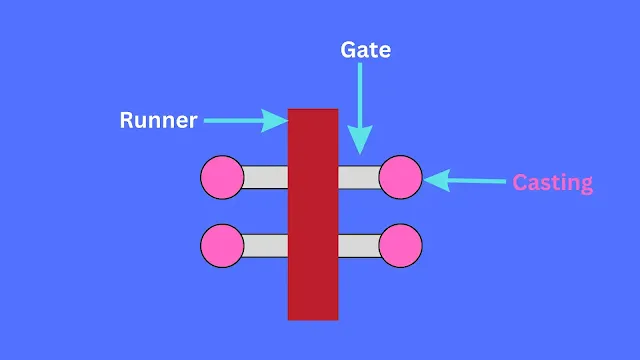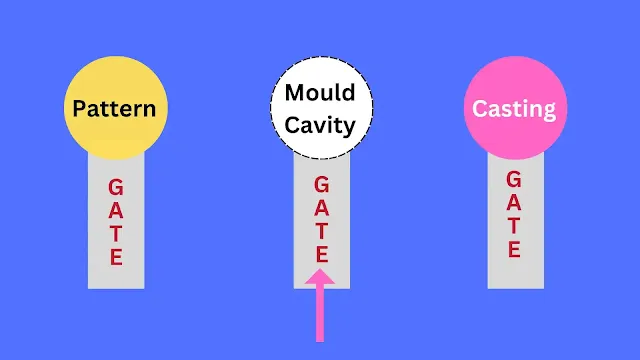Gated Pattern

|
| Gated Pattern In Casting |
At times there is a need for producing multiple casting at a time in one casting cycle. Casting needs to be produced in mass by using patterns.
Match plate patterns can produce multiple casting at the same time but it does not have much flexibility over the design and flow of molten metal to the cavity while producing casting.
In order to solve this problem casting engineers use gate patterns for manufacturing casting in the foundry.
I have discussed the gated pattern article in detail below covering diagrams, working, application, advantages, disadvantages and MCQ practice questions.
{tocify} $title={Gated Pattern In Casting Table of Content }
What is a gated pattern in casting?
A gated pattern is a pattern used for mass production of small-size casting in the sand casting process.
The gated pattern has the following components:
- Loose patterns for producing mould cavities.
- Gate for the entry of molten metal to the mould cavity.
- Common runner connecting to all the gates.
Gated patterns are made by attaching loose patterns to the gating system as shown in diagram (a) below. These patterns can be of a variety of shapes and sizes according to customer requirements.

|
| (a) Gated Pattern |
These loose patterns are used to make a mould cavity into the sand mould as shown below in diagram (b). After the mould cavity is made runners and gates are carved in the sand mould to allow the flow of molten metal from the pouring basin to the cavity.

|
| (b) Gated Pattern Mould Cavity In Sand Casting |
Molten metal is poured into the pouring basin and is allowed to flow to the mould cavity through a common runner which connects to all gates as shown above in diagram (b).
As shown below molten metal is poured into a cavity made from a gated pattern and metal has started to solidify in the casting process in diagram (c).
 |
| (c) Gated Pattern Molten Metal Pouring Operation |
Gates ensure the flow of low turbulence molten metal to enter the mould cavity in exact quantity for producing high-quality sand casting.
After the molten metal has solidified in the cavity as shown in diagram (d) the casting is taken out of the mould cavity along with the entire gating system.

|
| (d) Gated Pattern With Gate and Runner |
Gating system elements such as gates and runners are separated from the main casting by the moulding machine.
At times the gate pattern is designed in such a way that gates become an internal part of the casting and there is no need to cut gates separately saving the fettling time in the casting process.
What material is used for producing a gated pattern in casting?
Metal pattern materials are used for producing gated patterns for mass-producing sand castings of compact size.
What is the function of a gated pattern?
The function of the gated pattern is to mass-produce small-size casting in large quantities by attaching multiple patterns with gates which feed the molten metal to the mould cavity through a common channel called a runner.
Gated Pattern Application
A gated pattern is used for mass-producing small casting. The list of casting produced is as follows:
- Car handles.
- Gate valves for steam engines.
- Check valves in a pneumatic system.
- Industrial vices.
- Engine rocker arms.
- Corner brackets and nuts/bolts.
- Metal and wax patterns are used in the investment casting process.
Gated Pattern Advantages
- Small-size complex and thin casting can be produced in larger quantities in the same casting cycle using just one pattern having multiple small loose patterns.
- The casting of different shapes can be cast as every casting has a separate mould cavity and an in-gate to control the flow of molten metal according to the shape of the casting.
- The exact amount of molten metal is fed into the mould cavity reducing excess metal in the mould and reducing machining.
- Every mould cavity has its own gate and supply of molten metal-producing sound casting.
- The moulding machine eliminates the time and effort to cut sprue and runners from casting as this step is automatic.
- Withdrawing patterns from mould is done on a moulding machine saving pattern withdrawal time for the operator.
- High-quality consistent casting can be manufactured as the flow of molten metal in the mould cavity is uniform and steady.
- Casting yield using this pattern increases as molten metal is not wasted in the gating area.
- The runner serves as the heart of the gated pattern in the casting process supplying molten metal efficiently.
- Gated patterns made of metal tend to reduce casting defects such as warp and increase the strength and toughness of the pattern.
- As casting is mass-produced it reduces the overall cost of the gated pattern.
- No hand-cutting of the pattern improves productivity and reduces foundry time for producing casting after using this pattern.
- Cores can be used along gated patterns to make hollow sections in the casting.
Gated Pattern Disadvantages
- Limitation on size of the casting, very large size casting cannot be manufactured as we see in the skeleton pattern.
- The design requirement of the pattern is more as every pattern needs a separate gate entry.
- High-skilled workmanship is required for making complex gated patterns.
- There is a cost associated with pattern withdrawal and removing the gating system from the pattern.
- The pouring temperature needs to be kept high to reduce molten metal solidification at the end gate.
- Molten metal travel distance is longer to reach the mould cavity as compared to mould cavities made by other patterns such as solid pattern, loose-piece pattern, piece pattern etc.
- Large-size complex shape casting cannot be made with this pattern only a simple shape design is advised.
Gated Pattern MCQ (Multiple Choice Question & Answer)
1) Which of the following patterns are used for mass-producing small-size casting having a controlled flow in the mould cavity using multiple gates?
2) Quality of casting improves using the separate gate for every mould cavity as we can control solidification rate, flow rate, and design gate according to the size of the mould cavity and design of the casting? State if the statement is true for the gate pattern in casting?
3) This pattern is made from metal material for the following benefits.
4) Which of the pattern produces complex casting in higher volume?
5) Which of the following casting products are produced using the gated pattern in the sand casting process?
Gated Pattern In Casting Summary
As shown below in diagram (d) three stages of producing casting using a gated pattern.

|
| (d) Gated Pattern Diagram |
- Step 1 - Make a gated pattern by assembling a loose pattern and gating system. Place a gated pattern and pour the sand on the pattern. Sand ram on the pattern.
- Step 2 - Remove the pattern from the sand to make a mould cavity using the moulding machine. The pattern used in this process makes cavities in both the cope and drag sections of the mould. They are basically split patterns given their own separate gate entry.
- Step 3 - Pour molten metal into the gating system and allow molten metal to flow in every separate mould cavity created by the gated pattern through a common runner.
- Step 4 - Remove the casting out after solidification and cut gates and runner from the final casting.
The gated pattern is one of the patterns among types of pattern in sand casting.
The gated pattern produces small casting in a larger quantity having high control over every casting production as the mould produced is multi-cavity mould and each cavity has its own gate entry.
Sand casting process using this kind of pattern gives higher casting yield, increases the production ability with reduced casting defect because of the controlled flow of molten metal in the mould and gives high-quality small-size casting products.
